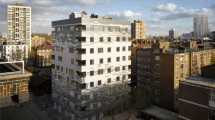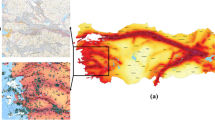Abstract
Non-circular tunnels such as horseshoe tunnel, constructed by tunnel boring machines (TBMs), are increasingly used due to their large utilization area in cross section, high mechanization degree of TBMs and high-level developed material technology which allows the lining structures with the high-stress capacity could be manufactured. However, there is still a limited number of studies carried out explicitly on the tunnel lining behavior excavated by the horseshoe-shaped shield. The current study is therefore aimed at presenting procedural steps for the determination of appropriate cross sections in horseshoe tunnel structures. The construction clearance of a double-track railway tunnel was taken into account as an example. A set of horseshoe cross sections were investigated using hyperstatic reaction method to estimate the tunnel lining behavior and to determine the optimal cross section in terms of structural forces. After that, a parametric investigation was conducted to highlight the effect of Young’s modulus of soil (Es), the coefficient of lateral earth pressure (K0), the thickness of lining (t) and the tunnel depth (H) on the horseshoe tunnel linings. The results showed that the higher the tunnel depth and the soil Young's modulus, the greater the effect of the tunnel geometry on the structural forces in the tunnel lining. The horseshoe tunnel lining behavior, especially in terms of the maximum bending moment, is significantly affected by the radii of lining sections along the tunnel boundary.













Similar content being viewed by others
References
Li J (2017) Key technologies and applications of the design and manufacturing of non-circular TBMs. Engineering 3(6):905–91. Doi: https://doi.org/10.1016/j.eng.2017.12.002
Wang J-H, Qiu W-G (2018) Mechanized tunnelling with large section horseshoe shape EPB-TBM first applied in loess mountain tunnel at Mengxi Huazhong Railway Line Baicheng Tunnel. In ITA-AITES, Chuzhou-Nanjing
Sammal A, Fotieva N, Bulychev N, Khrenov S (2004) Design of tunnel lining with variavle thickness located new ground surface (in Russian). J Min Inst 156:24–26
Lu A-Z, Zhang N, Kuang L (2014) Analytic solutions of stress and displacement for a non-circular tunnel analytic solutions of stress and displacement for a non-circular tunnel. Int J Rock Mech Min Sci 70:69–81. https://doi.org/10.1016/j.ijrmms.2014.04.008
Protosenya AG, Karasev MA, Belyakov NA (2016) Elastoplastic problem for noncircular openings under Coulomb’s Criterion. J Min Sci 52(1):53–61
Shi H, Bai M (2017) Plastic zone analysis of deep-buried, noncircular tunnel and application on the high-speed railway in the Karst Area. Math Prob Eng, pp 1–10. Doi: https://doi.org/10.1155/2017/9523267
Gospodarikov P, Zatsepin M (2019) Mathematical modeling of boundary problems in geomechanics. Gornyi Zhurnal 12. Doi: https://doi.org/10.17580/gzh.2019.12.03
Zhang C, Li W, Zhu W, Tan Z (2020) Face stability analysis of a shallow horseshoe-shaped shield tunnel in clay with a linearly increasing shear strength with depth. Tunnell Underground Space Technol 97. Doi: https://doi.org/10.1016/j.tust.2020.103291
He B-G, Li H-P, Zhang Z-Q (2020) The effect of earth pressure on the failure mode of high-speed railway tunnel linings. Eng Failure Anal 110. Doi: https://doi.org/10.1016/j.engfailanal.2020.104398
Ravandi EG, Rahmannejad R (2013) Wall displacement prediction of circular, D shaped and modified horseshoe tunnels in non-hydrostatic stress fields. Tunn Undergr Space Technol 34:54–60. https://doi.org/10.1016/j.tust.2012.11.001
Yoon J-U, Han J-W, Joo E-J, Shin J-H (2014) Effects of tunnel shapes in structural and hydraulic interaction. KSCE J Civ Eng 18(3):735–741. https://doi.org/10.1007/s12205-014-1325-1
Du D, Dias D, Do N (2018) Designing U-shaped tunnel linings in stratified soils using the hyperstatic reaction method. Eur J Environ Civ Eng 24(14):1–18. https://doi.org/10.1080/19648189.2018.1506827
Du D, Dias D, Do N (2020) Effect of surcharge loading on horseshoe-shaped tunnels excavated in saturated soft rocks. J Rock Mech Geotech Eng 12(6):1339–1346. https://doi.org/10.1016/j.jrmge.2020.08.001
Nguyen C, Gospodarikov AP (2020) Hyperstatic reaction method for calculations of tunnels with horseshoe-shaped cross-section under the impact of earthquakes. Earthq Eng Eng Vib 19:179–188. https://doi.org/10.1007/s11803-020-0555-0
Rahaman O, Kumar J (2020) Stability analysis of twin horse-shoe shaped tunnels in rock mass. Tunn Undergr Space Technol 98:1–18. https://doi.org/10.1016/j.tust.2020.103354
Nguyen TT, Do NA, Anatolyevich KM, Dang VK, Dias D (2020) Influence of tunnel shape on tunnel lining behavior. In: Proceedings of the institution of civil engineers-geotechnical engineering, pp 1–17. https://doi.org/10.1680/jgeen.20.00057
Bhattacharya P, Sriharsha P (2020) Stability of horseshoe tunnel in cohesive-frictional soil. Int J Geomech 20(9). Doi: https://doi.org/10.1061/28ASCE29GM.1943-5622.0001770
Du D, Dias D, Do NA, Oreste PP (2018) Hyperstatic reaction method for the design of U-shaped tunnel supports. Int J Geomech 18(6). Doi: https://doi.org/10.1061/(ASCE)GM.1943-5622.0001127
Besrodny KP, Lebedev MO (2017) About rock pressure loads on tunnel linings constructed using trenchless method. J Min Inst 228:649–654. Doi: https://doi.org/10.25515/PMI.2017.6.649
Wang S, Jin D, Ren B, Zhang X, Qiu K, Fan Y (2019) Instability process of crack propagation and tunnel failure affected by cross-sectional geometry of an underground tunnel. Adv Civil Eng, p 17. Doi: https://doi.org/10.1155/2019/3439543
Muskhelishvili NI (1977) Some basic problems of the mathematical theory of elasticity. Springer, Dordrecht, p 732
Du D, Dias D, Do NA, Vo TH (2020) U-shaped tunnel lining design using the hyperstatic reaction method—influence of the invert. Soils Found 60(3):592–607. https://doi.org/10.1016/j.sandf.2020.02.004
D. M. Potts and L. Zdravković, Finite element analysis in geotechnical engineering, vol. 1, Thomas Telford Limited, 1999.
TCVN (1988) Hầm đường sắt và hầm đường ô tô -Tiêu chuẩn thiết kế. 4527-1988.
Oreste P (2007) A numerical approach to the hyperstatic reaction method for the dimensioning of tunnel supports. Tunn Undergr Space Technol 22(2):185–205. https://doi.org/10.1016/j.tust.2006.05.002
Do NA, Dias D, Oreste P,. Maigrea ID (2014) The behaviour of the segmental tunnel lining studied by the hyperstatic reaction method. Eur J Environ Civil Eng 18(4): 489–510. Doi: https://doi.org/10.1080/19648189.2013.872583
Do NA, Dias D, Oreste P (2014) 2D seismic numerical analysis of segmental tunnel lining behaviour. Bull N Z Soc Earthq Eng 47(3):1–11. https://doi.org/10.5459/bnzsee.47.3.206-216
Do NA, Dias D, Zhang Z, Huang X, Nguyen TT, Pham VV, Nait-Rabah O (2020) Study on the behavior of squared and sub-rectangular tunnels using the Hyperstatic Reaction Method. Transp Geotech 22. https://doi.org/10.1016/j.trgeo.2020.100321
Du D, Dias D, Do NA (2020) Lining performance optimization of sub-rectangular tunnels using the hyperstatic reaction method. Comput Geotech 117. https://doi.org/10.1016/j.compgeo.2019.103279
Takano YH (2000) Guidelines for the design of shield tunnel lining. Tunnel Underground Space Technol 15(3):303–331. https://doi.org/10.1016/S0886-7798(00)00058-4
Huebner KH, Dewhirst DL, Smith DE, Byrom TG (2001) The finite element method for engineers. John Wiley and Sons, inc, New York
Li W, Zhang C, Zhu W, Zhang D (2019) Upper-bound solutions for the face stability of a non-circular NATM tunnel in clays with a linearly increasing undrained shear strength with depth. Comput Geotech 114. https://doi.org/10.1016/j.compgeo.2019.103136
Brinkgreve R (2002) Plaxis: finite element code for soil and rock analyses. Delft, Netherlands
Çelik S (2017) Comparison of Mohr-Coulomb and hardening soil models numerical estimation of ground surface settlement caused by tunneling. Iğdır Univ J Inst Sci Technol 7(4):96–102. Doi: https://doi.org/10.21597/jist.2017.202
Chen K-H, Peng F-L (2018) An improved method to calculate the vertical earth pressure for deep shield tunnel in Shanghai soil layers. Tunn Undergr Space Technol 75:43–66. https://doi.org/10.1016/j.tust.2018.01.027
Miliziano S, Lillis AD (2019) Predicted and observed settlements induced by the mechanized tunnel excavation of metro line C near S. Giovanni station in Rome. Tunnell Underground Space Technol 86:236–246. Doi: https://doi.org/10.1016/j.tust.2019.01.022
Migliazza M, Chiorboli M, Giania G (2009) Comparison of analytical method, 3D finite element model with experimental subsidence measurements resulting from the extension of the Milan underground. Comput Geotech 36(1–2):113–124. https://doi.org/10.1016/j.compgeo.2008.03.005
Vinod M, Khabbaz H (2019) Comparison of rectangular and circular bored twin tunnels in weak ground. Underground Space 4(4):1–12. https://doi.org/10.1016/j.undsp.2019.03.004
Rostami A, Asghari N, Ziarati MA, Jahani S, Shahi B (2016) Investigating effect of tunnel gate investigating effect of tunnel gate inserted forces on its coverage and soil surface settlement. J Civ Eng 6(3):358–369. https://doi.org/10.4236/ojce.2016.63030
Abdellah WR, Ali MA, Yang H-S (2018) Studying the effect of some parameters on the stability of shallow tunnels. J Sustain Min 17(1):20–33. https://doi.org/10.1016/j.jsm.2018.02.001
Besharat V, Davoodi M, Jafari MK (2014) Variations in ground surface responses under different seismic input motions due the presence of a tunnel. Arab J Sci Eng 39:6927–6941. https://doi.org/10.1007/s13369-014-1260-y
Mahajan S, Ayothiraman R, Sharma KG (2019) A parametric study on effects of basement excavation and foundation loading on underground metro tunnel in soil. Indian Geotechnical Journal 49:667–686. https://doi.org/10.1007/s40098-019-00361-x
Terzaghi K (1941) General wedge theory of earth pressures. Transactions, ASCE 108.
Blom CBM Design philosophy of concrete linings for tunnels in soft soils. PhD thesis, TU Delft, Delft Univ. of Technology, Delft, Netherlands
Acknowledgements
The first author is supported by the Saint Petersburg Mining University.
Funding
This research was funded by the Vietnam Ministry of Education and Training under grant number B2022-MDA-06. This funding is greatly appreciated.
Author information
Authors and Affiliations
Corresponding author
Ethics declarations
Conflicts of interest
The authors declare that they have no conflict of interest.
Additional information
Publisher's Note
Springer Nature remains neutral with regard to jurisdictional claims in published maps and institutional affiliations.
Rights and permissions
About this article
Cite this article
Nguyen, T.T., Do, N.A., Anatolyevich, K.M. et al. Numerical Investigation of the Horseshoe Tunnels Structural Behavior. Indian Geotech J 52, 799–814 (2022). https://doi.org/10.1007/s40098-022-00618-y
Received:
Accepted:
Published:
Issue Date:
DOI: https://doi.org/10.1007/s40098-022-00618-y




